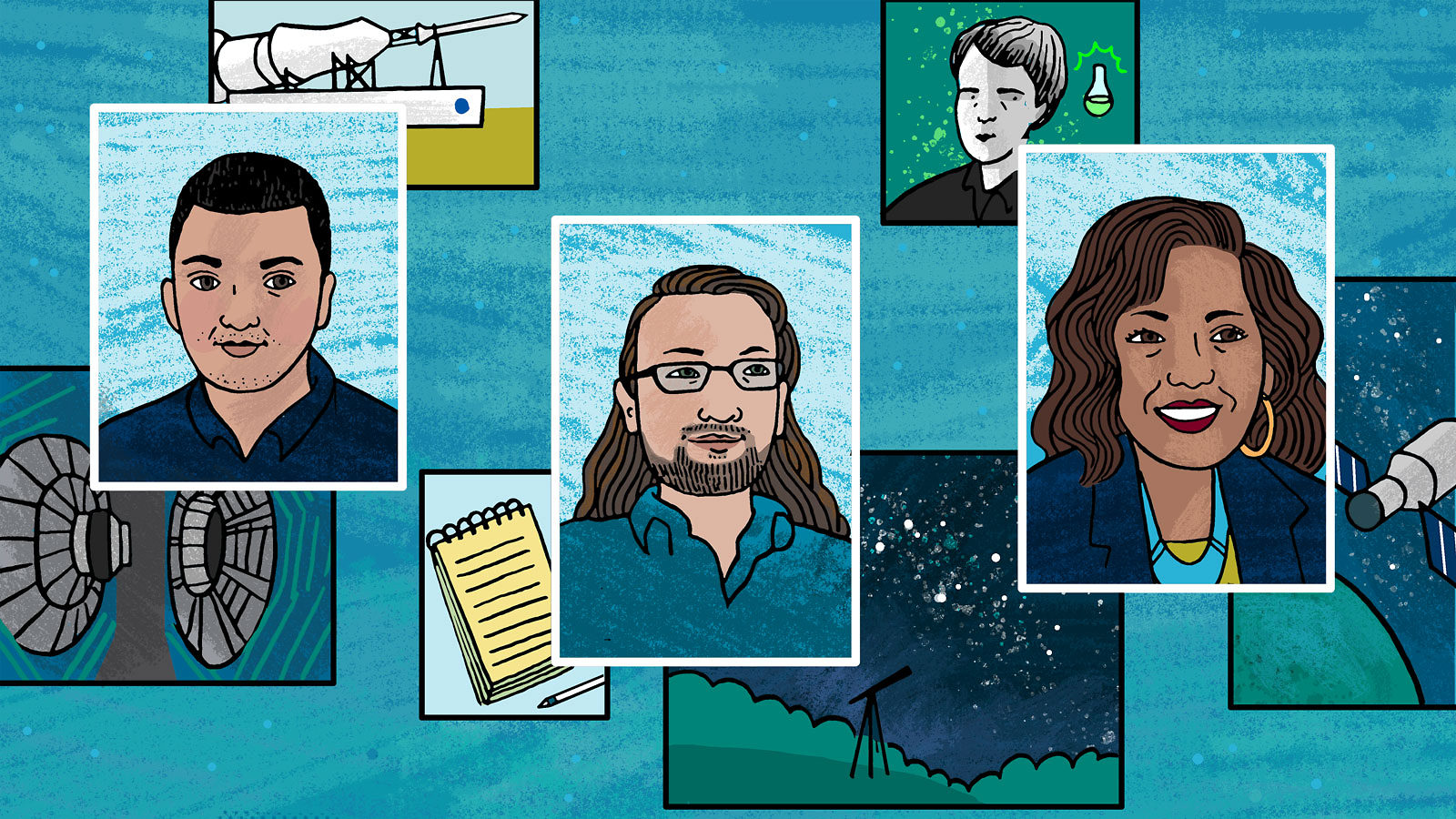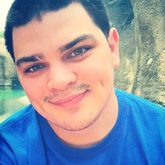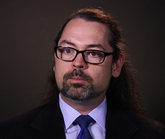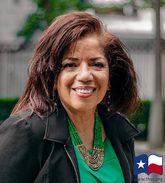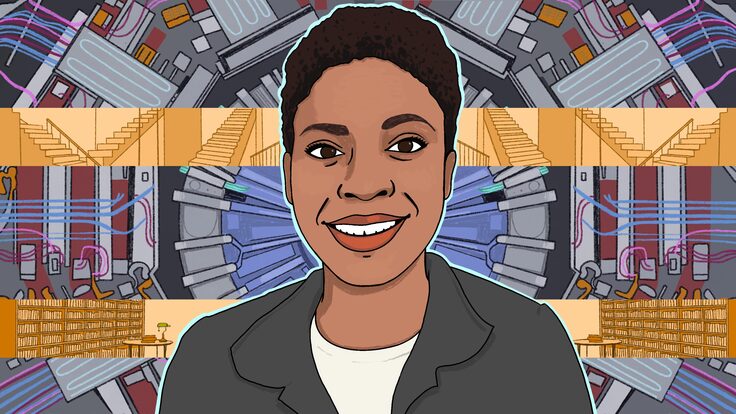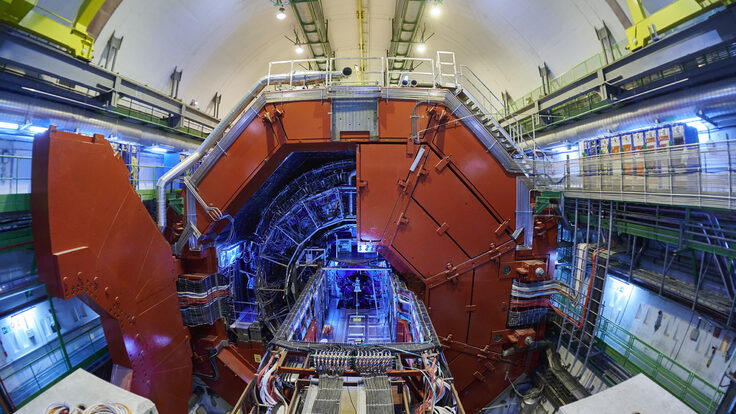Students come into science from a variety of backgrounds, facing a variety of circumstances.
The Fisk-Vanderbilt Master’s-to-PhD Bridge Program, a partnership between Fisk and Vanderbilt universities in Nashville, is meant to take that into account. It helps students overcome external hurdles to reach their potential in PhD-level STEM research.
Students finish the coursework, training or research they need to complete a master’s degree at Fisk—a small, private, historically black university—and continue with their doctorates at Vanderbilt or at another institution.
Meet three people who were accepted into the program, all of whom are now working to help people around them as well.
Brandon Soubasis
Although he grew up within view of NASA’s Johnson Space Center in Texas, Brandon Soubasis was an unlikely candidate for a science degree. As a middle schooler, Soubasis found himself responsible for the care of his mother, an immigrant from Panama suffering from major health problems, and his two younger brothers. His father was in jail.
Soubasis fell behind in coursework and was placed in a special education program. His family did not expect him to earn a degree beyond high school.
But an astronomy class he took his senior year of high school sparked his interest, and he decided to apply to Texas State University.
He started freshman year two levels below college algebra. But when he developed an interest in particle physics his sophomore year, he knew he would have to catch up. “I knew I needed to be good at math to be a good scientist,” Soubasis says. “I had to force myself to take these classes.”
Soubasis says he spent a lot of time reading about the Large Hadron Collider and the fundamental properties that determine the makeup and structure of the universe. Texas State did not offer a research program in particle physics, so Soubasis commuted every day to the University of Texas at Austin.
“While taking care of my sick mom, working a part-time job to pay for tuition, and going to school full-time, it was emotionally and mentally exhausting to drive an hour north each day,” he says. But he wanted to get as much exposure as possible to graduate students and postdocs working in the particle physics research group.
Near the end of undergrad, Soubasis began applying for graduate school. To his dismay, many of his professors told him he wasn’t ready; his grades weren’t high enough.
Soubasis’s advisor, Alfredo Gurrola, encouraged him to apply for the Fisk-Vanderbilt bridge program. In 2016, he was accepted as the only graduate on the particle physics track.
Whereas students entering the graduate program can feel “like they’re being thrown to the wolves,” Soubasis says, “the bridge program gives a lot more guidance.” Each semester, students in the bridge program are paired with tutors and attend regular meetings and get-togethers. Soubasis showed immediate improvement as he found comfort in the community established among the bridge program students.
Currently in his final year of the program, he is getting straight A’s, even excelling in one of the most challenging courses offered in the program, Advanced Electrodynamics 2.
Soubasis acts as a mentor for first-year students and is a part of the committee that helps the incoming students with professional development. And now instead of reading about research at the LHC, he’s doing it: Soubasis searches for new phenomena and assists with pixel detector upgrades as a member of the CMS experiment.
Dave Caudel
During high school Dave Caudel had little interest in his classes. Once he learned how to maintain a B average with the least amount of effort possible, it was easy for him to check out.
“Many facts lacked context for me, and without the 'why,' I didn't see the point in learning something,” Caudel says. “Being told ‘because I said so’ was a quick way to lose my attention.”
Caudel didn’t know it until his 30s, but he is on the autism spectrum, meaning he has a neurological variation found in less than 3 percent of children in the United States. People on the autism spectrum may communicate, behave, interact or learn differently from the majority of the population, which he says could be the reason he felt disengaged in classes more aimed at neurotypical students.
After graduation, Caudel joined the military as a journalist and served for seven years. He says he had never planned to attend college, but after going through multiple unfulfilling jobs post-military, he knew higher education had to be his next step.
Caudel enrolled as an English major at Tennessee State University. His original goal was to enter the civilian world of journalism after graduation. But freshman year, his plans took a turn. He signed up for a class that would fulfill his science requirement: astronomy. He was fascinated. Suddenly, he understood the appeal of science class. By the end of his first semester, he’d changed his major to physics.
“You know, [my astronomy professor] understood all sorts of things I wasn’t ever aware of,” Caudel says. “So I took another science class and then another one, and next thing I knew, I was a physicist.”
During his undergraduate years at TSU, Caudel worked as an intern and then research assistant at nearby Fisk University Laboratories. In his final years at TSU, he decided he wanted to get his PhD.
He had research experience and publications, but he received a low score on his Physics GRE. Almost every graduate school to which he applied rejected him.
He was accepted into one program, though: the Fisk-Vanderbilt bridge program, which excludes the Physics GRE from its application.
“They look for ‘grit,’ the ability to keep trying after failure,” Caudel says. “An academic record and the quality of one’s undergraduate schooling is more a reflection of how wealthy your parents were than a predictor of success in science. A student with a lot of grit is more likely to succeed in a PhD program.”
Caudel describes the bridge program as “an amazing support network” that adapted to his strengths and weaknesses. Caudel found an advisor whose son has autism. “He always seemed to get me,” Caudel says. “He always spoke plainly and never answered a follow-up question with some variation of ‘that's a dumb question, everybody knows that.’”
Along with a well-paired advisor, the bridge program provided an extensive amount of support through tutoring, counseling and other resources, which Caudel says were key to his success.
The day Caudel received his PhD, he was offered a position as executive director of Vanderbilt’s Frist Center for Autism and Innovation. According to its website, the center is Vanderbilt’s “core academic research partner within a larger community-based effort” that aims to match autistic adults with employers.
“If you take a neuro-diverse mind and you put it in the right environment with the right sort of guidance and protection, it can absolutely thrive,” Caudel says.
Today Caudel remains an active mentor and tutor for current bridge program students. “I owe this family everything,” Caudel says. “It’s a debt I can never repay.”
Helen Jackson
As a child, Helen Jackson spent her time reading the biographies of scientists, pushing ahead of her grade level in her studies, and conducting experiments with what she could find around her home.
“Marie Curie’s biography was my inspiration,” Jackson says. “By the time I was 12 years old I had made up my mind that I wanted to be a nuclear physicist.”
One reason she focused so much on her studies: It took her mind off of her personal life. “I was in a very difficult personal home situation, and so studying was my refuge,” she says.
Throughout most of her childhood, Jackson’s parents were absent, Jackson says. They separated when she was 5 years old. Jackson’s mother was hospitalized for extended periods of time and was later diagnosed with severe dementia and placed in a nursing home. Her father suffered from post-traumatic stress disorder after his military service and had no options for treatment. Jackson and her three siblings were passed between relatives and friends.
Between the ages of 10 and 16, Jackson took up a paper route and worked at a five-and-dime discount store to support herself. Around age 14 she began working as a maid. At lunch time at school, she offered tutoring to her classmates. “I was able to come up with enough to buy myself lunch doing this,” Jackson says.
Despite her difficult home situation, Jackson excelled in her courses throughout secondary education. When she took the SAT, she received a perfect score.
Jackson received offers from colleges across the country. She says she planned to attend MIT, but she did not have the guidance to follow through with her decision. Assuming she could accept offers later, she instead married young and had her first child. The relationship between Jackson and her first husband turned abusive, however, so she says she made the decision to leave.
Still driven to become a physicist, a few years later she started her undergraduate education. Toward the end, Jackson found a job at NASA as a systems engineer intern working on NASA’s satellite systems. In 1983 Jackson applied for the position of mission specialist astronaut.
During her time at NASA, she met her second husband. Her eldest son was struggling in public school, so she decided to cut back her hours at work and try educating her children herself through homeschooling.
Jackson was working her way into a contract position and eight months pregnant when she received an important phone call from NASA: She had been selected for the astronaut program, an opportunity that could make her the first black woman in space. She declined. “I stepped away from the phone and wanted to faint. It was painful, it was a disappointment,” Jackson says.
What Jackson didn’t know was that this decision probably saved her life. In 1986, the Challenger Space Shuttle, with her class of astronauts on board, exploded. None of the astronauts survived.
For the next few years, Jackson focused on homeschooling her children while also tutoring and mentoring children in public and private school.
In 2004 Jackson decided to continue educating herself. She enrolled at Fisk University, where she received her master’s degree in physics. She accepted an invitation to join the Fisk-Vanderbilt bridge program and was given an advisor, options for additional tutoring, funding to cover the costs of scientific conferences, and aid with a smooth transition from a historically black university to a predominantly white institution.
“There is a history of hostile climates for African American students, particularly in the subjects like physics, at PWIs. There is often not a welcoming environment,” Jackson says. "[In the bridge program] it was good to know that you have someone standing behind you that’s supportive."
In 2007 Jackson’s husband died. Finding herself suddenly a widowed mother of five facing expensive medical bills to take care of one of her children, among other issues, Jackson left Vanderbilt.
By invitation, Jackson began working as a full-time research assistant with the Air Force. While there, she authored multiple publications and developed a patent for a method of radiation-hardening semiconductors that the Air Force still uses today. In 2014, she finished her PhD in applied physics in the nuclear engineering program at the Air Force Institute of Technology.
Jackson now works with the Defense Threat Reduction Agency in the realms of artificial intelligence and national security. She continues to tutor and mentor students through the New York Academy of Sciences and other organizations.



